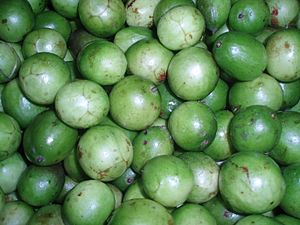Imbu facts for kids
Quick facts for kids Imbu |
|
|---|---|
 |
|
| Scientific classification | |
| Genus: |
Spondias
|
| Species: |
tuberosa
|
The Imbu (scientific name: Spondias tuberosa) is a special plant from northeast Brazil. It is also called the Brazil plum or umbu. This plant grows in a dry area called the Caatinga, which is a type of scrubland.
The imbu fruit is round and can be light yellow to red. It is usually about 2–4 cm (about 1-1.5 inches) big. The fruit has a slightly tough skin, but its inside is soft and juicy. It tastes sweet and has a unique smell. The imbu fruit can be as small as a cherry or as big as a lemon. When ripe, its skin is smooth and can be green or yellow. Inside the tasty fruit is a large, dark seed. The imbu tree is usually small, not much taller than 6 meters (about 20 feet). It has a wide top that can spread out quite a bit.
What's in a Name?
The name "imbu" comes from an old local language. It means "tree that gives drink." This name is perfect because the imbu tree is amazing at storing water. It has a strong root system with many tubers, which are like underground storage tanks. These tubers can hold up to 3,000 liters (about 790 gallons) of water! This helps the tree survive during the long, dry summer months.
The imbu tree grows wild and starts making fruit after about ten years. Once it's mature, it can produce a lot of fruit. A single tree can give up to 300 kilograms (about 660 pounds) of fruit in one harvest!
How People Use Imbu
The imbu tree is very important for people in one of Brazil's driest regions. This area is often poor, and people mainly farm corn, beans, sheep, and goats. Dried and salted goat meat is a key food here.
People carefully pick the imbu fruit by hand. This is because the fruit can get damaged easily. They put the picked fruit into baskets and bags. In the past, people would hit the branches with long poles to get the fruit. But this often hurt the fruit's taste, so now they pick it gently.
Imbu in the Kitchen
You can eat imbu fruit fresh, right off the tree! It is also used to make many delicious foods. People turn it into jams or other sweet treats, like a fruit cheese.
In a region called the Sertão, people cook the imbu fruit until the skin and pulp separate. Then, they drain the liquid, mix it with sugar, and cook it for two more hours. This process makes a shiny, jelly-like spread called geléia. It has a slightly tart taste.
Besides this thick paste, imbu is used to make:
- Fruit juice: A refreshing drink.
- Vinagre: This is juice pressed from very ripe imbu fruit.
- Jam: Made by pressing together layers of dried imbu paste.
- Compôte: A sweet dish made by mixing the fruit and sugar in jars.
Another popular treat is umbuzada. This is a rich drink made by mixing fresh imbu pulp (or vinagre if fresh fruit isn't available) with milk and sugar. It's so filling that it can sometimes be a meal on its own! Imbu fruit is also great for mixing with other fruits like gooseberries or plums. It's used in fruit juices, jams, and sorbets.
Helping Imbu Grow
Not long ago, many people didn't pay much attention to the imbu fruit. But now, different groups are working to make it more popular. Organizations like IRPAA/PRO CUC and others have helped improve how people see imbu products.
These groups have supported a local cooperative called COOPER-CUC. This cooperative makes imbu products without any added flavors or colors. They work in a small workshop in Uauá, a town in the state of Bahia. These efforts help make sure that imbu products are of high quality. They also help promote these products in Brazil and around the world.
The goals of these projects are big. They want to:
- Improve the market for local imbu products.
- Create new job opportunities for people.
- Help local people earn more money.
- Protect the environment where imbu trees grow.
- Help local communities, especially women, organize and work together.
See also
 In Spanish: Umbú para niños
In Spanish: Umbú para niños

